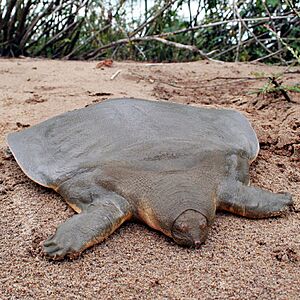Asian giant softshell turtle facts for kids
Quick facts for kids Asian giant softshell turtle |
|
|---|---|
 |
|
| Conservation status | |
| Scientific classification | |
| Genus: |
Pelochelys
|
| Species: |
cantorii
|
| Synonyms | |
|
|
The Asian giant softshell turtle (Pelochelys cantorii) is a very large freshwater turtle. It is also known as Cantor's giant softshell turtle or the frog-faced softshell turtle. This amazing animal lives in rivers and streams in Southeast Asia. Sadly, it is a critically endangered animal. This means it is at a very high risk of disappearing forever.
Contents
About This Turtle's Family
Scientists are still learning about the Asian giant softshell turtle. They think that what we call P. cantorii might actually be a few different types of turtles. Other similar turtles, like P. bibroni and P. signifera, live only in New Guinea. The P. cantorii lives in other parts of Asia.
What Does It Look Like?
The Asian giant softshell turtle has a wide head. Its small eyes are very close to the tip of its nose. Its shell, called a carapace, is smooth and olive green. Young turtles might have dark spots on their shells and heads. They can also have yellow colors around their shells.
How Big Can It Get?
This turtle is one of the biggest freshwater turtles in the world. It can grow to be very large. Some reports say its shell can be about 70 to 100 cm (28 to 39 in) long. This means it can weigh over 100 kg (220 lb). That's like a small motorbike!
How It Lives and Has Babies
The Asian giant softshell turtle is an ambush predator. This means it hides and waits for its food. It mainly eats meat, like crustaceans (crabs, shrimp), mollusks (snails, clams), and fish. Sometimes, it might also eat some water plants.
Hiding and Breathing
This turtle spends most of its life, about 95% of the time, buried in the sand. Only its eyes and mouth stick out. It stays very still. It only comes to the surface twice a day to take a breath.
Laying Eggs
Female turtles lay their eggs in February or March. They dig nests on riverbanks. Each nest can have between 20 and 28 eggs. The eggs are about 3.0 to 3.6 centimetres (1.2 to 1.4 in) wide.
Where Does It Live?
The P. cantorii turtle mostly lives in slow-moving, freshwater rivers and streams. It can also be found in some coastal areas. You can find this turtle in many countries in Asia. These include eastern and southern India, Bangladesh, Burma, Thailand, Malaysia, Laos, Cambodia, and Vietnam. It also lives in eastern and southern China, the Philippines (on islands like Luzon and Mindanao), and Indonesia (on islands like Kalimantan, Java, and Sumatra).
Helping This Endangered Turtle
The Asian giant softshell turtle is a Critically Endangered animal. This means it is in great danger of disappearing. Its homes are being destroyed, and it has vanished from many places where it used to live.
Finding Them Again
Before 2007, people hadn't seen this turtle in Cambodia since 2003. But in 2007, a survey found many of them along a 48 kilometres (30 mi) part of the Mekong River. This was great news!
In the Philippines, a young Cantor's turtle was found in 2001. It was captured by a fisherman. This turtle was later sent to Chicago to be studied. Organizations like the Zoological Society of London are working to protect this special turtle.
Etymology
The turtle's specific name, cantorii, was given to honor a Danish zoologist named Theodore Edward Cantor.
Images for kids



